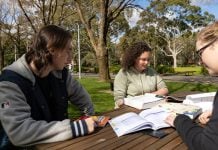Ever walk past those colourful helix statues wondering what’s happening inside the labs of the La Trobe Institute of Molecular Science? Inside LIMS highlights the ground-breaking research happening on the top floors of our very own LIMS building, as well as revealing the stories of the staff and students behind the discoveries.
This week, MyLaTrobe’s Lakshmi Ganapathy speaks to Rahul Sanwlani, a third-year PhD student looking at how Extracellular Vesicles (EVs), specifically those found in cows’ milk, can be applied in cancer treatment, under the supervision of Prof Suresh Mathivanan.
Let’s start with what brought you to LIMS.
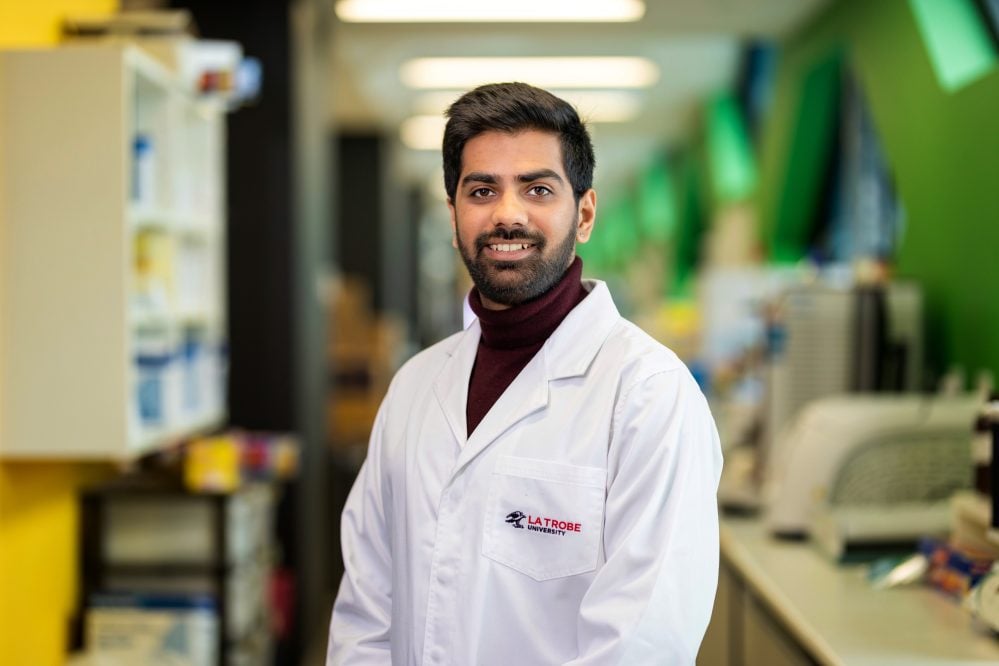
Prior to coming to Australia, I was in Ireland for a couple of years…Ever since I opted for Biology as one of my majors in school, I knew that academic research was something I want[ed] to do later on in life.
I first tried doing this in Ireland where I did my Masters, and I wanted to go and do a PhD there, but the circumstances [were] not favorable…I did not end up getting a scholarship, because I think most of the European universities want the scholarships to go to domestic students rather than internationals.
That’s when I had to make the move back to India, and then I started looking for places…I stumbled upon this course [at] La Trobe University, the Masters of Biotechnology and Bioinformatics, and I joined that…came here, studied for two years, did my Masters again. Luckily the Masters here is designed in a way that the first year is all coursework…the second year is not coursework, it’s entirely research, which is absolutely essential for somebody like me who wants to go for an academic career. In that second year we were given options to go and meet potential supervisors in LIMS. That’s where I met Suresh. I knew him from the very first day of my Masters program… the first lecture that I attended as a part of my Masters was given by Suresh, on Bioinformatics. That’s when I got introduced to him and he asked me about my future plans.
At the end of every lecture Suresh highlighted the research projects that were being carried out in his lab. It encouraged me to read more about it through the papers they published, and that’s where I got interested in extracellular vesicles and their role in cancer.
Sounds like exactly the degree you were looking for! What’s your experience been like working at LIMS?
Prior to commencing my research year with him, I was a part time intern in [Suresh’s] lab…trying to associate with the people…trying to understand what other projects they work on…the rapport that I developed from there was really motivating for me. That was a big factor [in why] I selected Suresh’s lab for my Masters…The lab members were very supportive; more than Suresh, they were my mentors in the lab.
Suresh is the principal investigator, he’s the lab head, of course his support matters, but when you have such a favourable environment…that is what makes you keep going.
So, the experience has been absolutely amazing. I had no research experience whatsoever…everything I had to learn from scratch…Postdoctoral fellows, or even my senior PhD students were very helpful. They trained me from scratch, they made sure that I slowly start[ed] becoming independent and capable of doing things on my own…then of course the other labs are amazing. It’s a very collaborative environment…we have collaborations with most labs in LIMS and all the people work together, they help each other.
That’s such a supportive environment. What’s been the highlight of your time here?
I’m an international student, so I do not have family here. I have spent seven days of the week in LIMS at moments… if I don’t have any hesitation spending seven days a week here, then there’s definitely something in LIMS that makes me motivated and makes me want to come here on the weekends and do my research.
I think it’s mostly the support from my lab members. The journey has been very smooth because of them. Of course, Suresh has been an amazing mentor. He’s a genius. He’s [so] successful at a very young age, and that is what motivates us to reach there.
Coming from an international background, when you do not have local support…this is [the] support you look for. I’m lucky enough that I got it and I had the right people to guide me at every step.
What’s an average day like for you in LIMS?
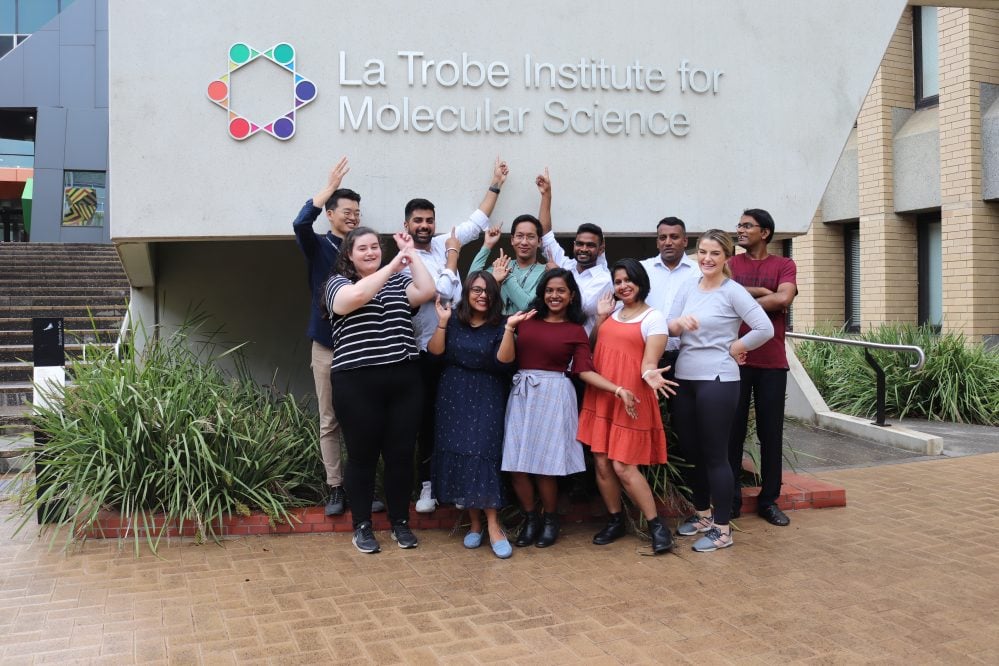
I normally just have a look at how my cells are growing and [if] everything is going fine. [I] plan my experiments, or [for] the experiments from the previous day which are going on, [I] just look after them. So, of course there’s a lot of experimentation, but other than that we spend a lot of time in front of computers as well, analysing the data, putting it together, making presentations, presenting in conferences, trying new collaborations…Then of course we have weekly meetings with Suresh, [to] discuss what we have planned for the rest of the week or the rest of the month for our project, and [to] get more ideas from him. We have weekly lab meetings as well… [to find out] what other members in our lab have been up for the last two months…what is new in the field, what kind of research is going on in other places in the world…This is how a day is run.
What’s something you wish more people knew about LIMS?
First, there’s the kind of work environment that we have here – such a supportive environment! A lot of people are still not aware of how this facility runs, like a family…of course the primary contributing factor being the kind of mentorship and the leadership that we have here. The people who run their labs here are so accomplished, they’re so successful…the kind of capabilities that we have here, I think it’s still not very exposed as a facility.
I think it’s also an issue with any other research facility within La Trobe, that we are not as exposed as other research institutes in Melbourne are. We have a lot of collaborations; our lab collaborates with Bio21 in the University of Melbourne, or WEHI. These are premier research institutes, you just [mention] the name and people know what you’re talking about…LIMS is yet to attain the same status. I think that is something we miss.
Now, onto your research – can you explain to us exactly what you’re looking at?
This all stems from the genius and ideas of Suresh…[he] had this random idea – ‘what happens when a person [has] cancer and is consuming milk?’ Milk is the most highly consumed natural beverage in the world, and [is] also is an abundant source of extracellular vesicles.
[When EVs are] released by one cell type in your body, they are capable of travelling long distances through your blood or through other fluids in your body, and reach[ing] cells at a different site… the EVs released by your brain are capable of reaching your liver…this is how your organs communicate.
We wanted to understand…are these EVs capable of mediating similar communication between two different organisms – a cow and a human? So, [for] EVs released by a cow, [are they capable of making changes when] they enter a human system?
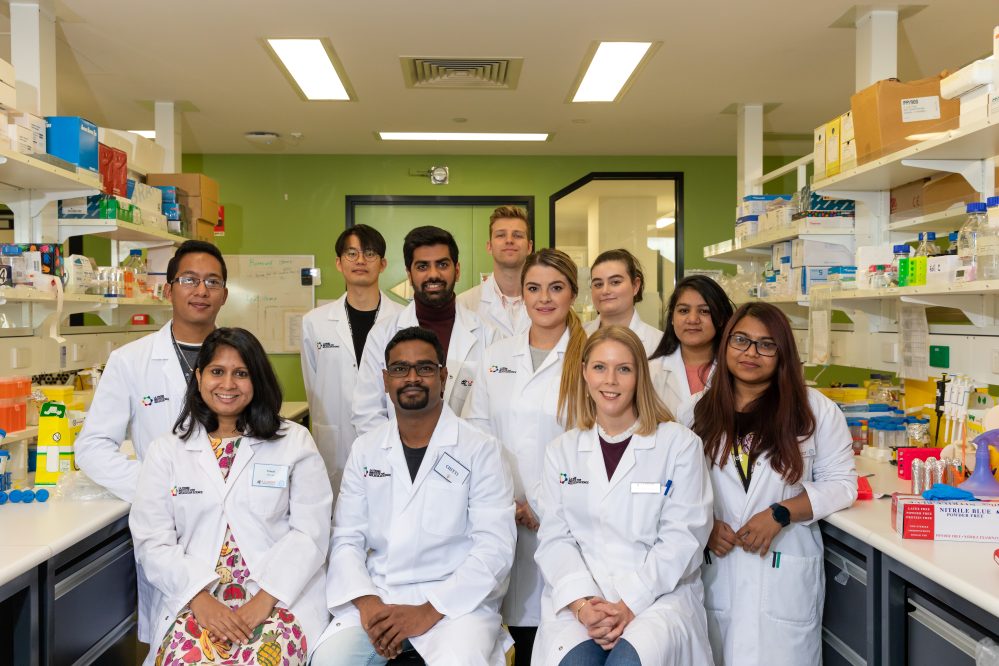
Your gut has acids in it…whatever you eat gets digested there. Consider EVs as a sphere, and inside these spheres you have a cargo of proteins, nucleic acids and a lot of other biomolecules. It’s really important that these biomolecules are maintained in a stable, bioactive state and they do not get digested in our stomach…to reach where they are intended to go. EVs serve to protect these biomolecules by harbouring them within a lipid bilayer and maintaining them in a functional state.
We label[led] these EVs with some fluorescent molecules and we fed them to mice, and after certain time points we imaged these mice. We [saw] that the EVs are capable of producing this fluorescent signal, confirming that they were reaching heart…liver…kidneys, spleen and of course the gastrointestinal tract.
So there are EVs in the milk you get at the supermarket?
In this project we used both raw and commercial milk. We had the commercial milk, the one we get at Coles or Woolies, and then Suresh with his PhD student who initially began this project had gone around a trip in Victoria to different farms to collect raw milk from cows…they wanted to study whether the raw and the commercial milk EVs ha[d] similar properties.
So you’ve found EVs are able to reach different organs; presumably looking at cancer progression was your next step? How did that work?
We had mice models…we induce cancers and once we know that the mice are developing tumours, we start treating them with milk EVs…we wanted to understand whether these EVs w[ould] control the growth of the tumours and the rate at which [they] spread.
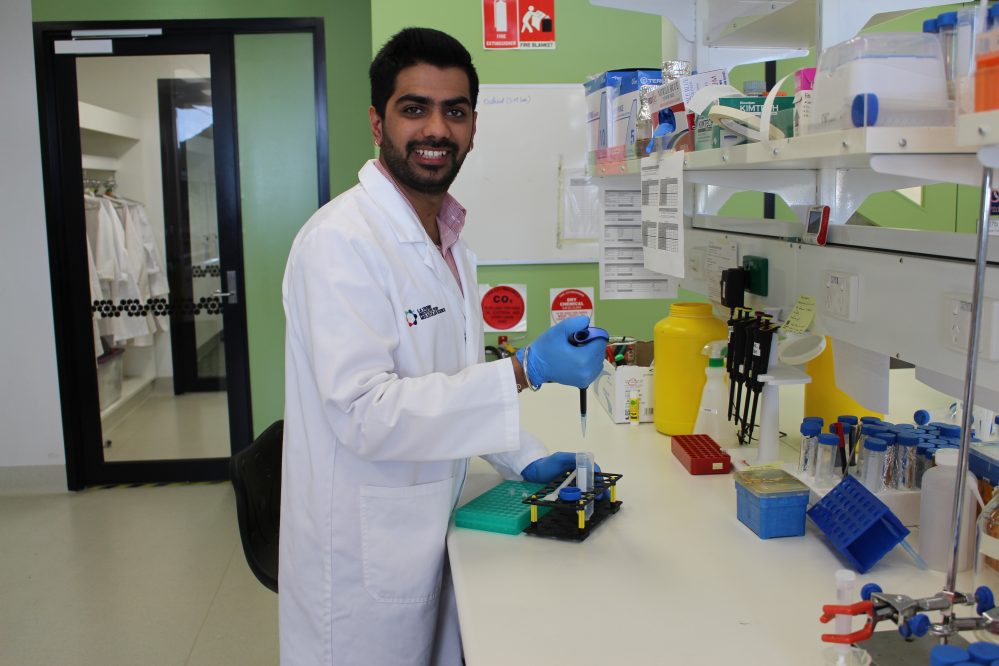
The challenge with treating cancers is the rate at which they spread. Breast cancer is not just breast cancer in the higher stages; once the patient has progressed to the end stages of cancer, the cancer can spread to different organs of the body, so we wanted to understand whether the EVs [would] influence that process.
In the untreated mice the tumours were growing faster, but where we did the treatments, the tumours were smaller…this helped us to confirm that the primary functional effect of these milk EVs is that they slow down the growth of the cancer.
When it comes to understanding whether these EVS are capable of stopping the spread of the cancer or not, we observed that the cancers were spreading faster than before. So in a way, they were beneficial but had a disadvantage as well – yes, they stop your breast cancer in the first place, but you might develop tumours in your liver or lungs faster.
But if you [perform] surgery, remove the primary tumor, and then feed the mice [EVs], the rate at which these cancer[s] spread also reduces.
So the timing of giving EVs to a patient really is important – if you give it to a person who still has a primary tumour in the body, it’s not entirely therapeutically beneficial [and] the patient is going spread the cancer, but if you give it to a person who has undergone surgery then it’s really beneficial, as the tumour growth at secondary sites is slowed.
Sounds like there’s both pros and cons – what does this mean for how we treat cancer?
There’s two ways to deal with this now. You give it to a patient who has undergone surgery, then you’re preventing further spread of cancer in the body, so it’s really beneficial there. The other angle…is what happens when you combine the extracellular vesicles with chemotherapy or other drugs.
A lot of people are now using these vesicles and artificially injecting drugs inside them and then putting them in your body, [to understand] if it improves the efficacy of treatment…these vesicles will specifically take the drug to the tumour cell, reducing the side effect…
Chemotherapy drugs have a lot of harmful effects; they reach your vital organs and damage them in the long run. Extracellular vesicles are providing you a targeted way to enter only the tumour cells…when you combine chemotherapy with milk EVs, the effect is much better than just the milk EVs or chemotherapy alone.
This doesn’t just have implications in cancer treatment or cancer progression. The wider implications are that this [proves] that two very different organisms, a cow and a human, can communicate with each other through Extracellular Vesicles.
That’s remarkable. What’s next for you and Suresh’s lab – more dairy related research?
We’ve already published a follow up paper where we are showing that milk, in combination with doxorubicin (which is a chemotherapy drug), is [more] helpful in treating cancers than using the two of them independently. I’m trying to do that now with a breast cancer model as well, combining chemotherapy and milk EVs.
The next step is to study probiotics…now my research is centred around studying the role of yogurt in cancer progression…People tell you to eat yogurt all the time because of the good bacteria…so [I’m studying] whether that good bacteria is communicating with you with the help of the EVs that are present in yogurt.











